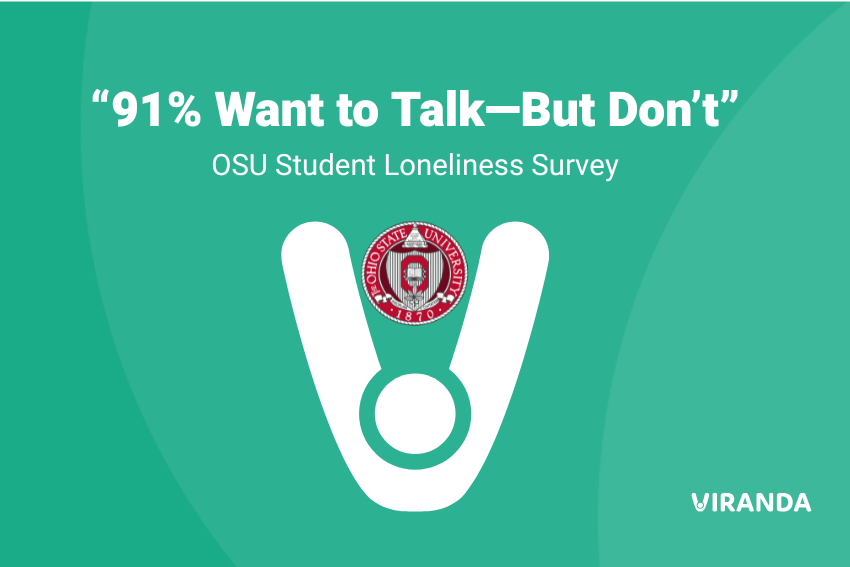At Viranda, we believe real change begins with real listening. So as part of our app launch at Ohio State University, we decided to do just that—listen.
We surveyed 150 OSU students—65% freshmen, 20% sophomores, 5% juniors, and 10% seniors, with a gender split of 60.6% female and 39.4% male.
We asked how often they feel the need to talk but don’t, what holds them back, how supported they feel on campus, and whether they’d open up in a safer, more anonymous space.
While responses naturally vary between groups—by year, gender, and experience—this post focuses on the overall trends across the full sample to keep it concise.
Below, we walk through each question and what it revealed.
TL;DR – Key Takeaways
- 91% of students said they sometimes or often want to talk about what they’re going through—but don’t.
- Fear of judgment and not wanting to burden others were the top reasons for staying silent.
- Students rated how “heard and understood” they feel on campus at just 6.1/10 on average.
- Over 80% said they’d try an anonymous, human-to-human chat platform.
- 136 out of 150 students said they’d be open to trying Viranda when it launches.
What OSU Students Actually Told Us
To truly understand student loneliness, we didn’t just ask one big question—we broke it down.
We explored how often students feel the need to talk but don’t, what holds them back, how supported they feel on campus, and whether they’d open up in a safer, more anonymous space. Below, we walk through each question and what it revealed.
How often do you feel like you want to talk, but don’t?

🟢 Summary: A full 91% of students told us they occasionally, often, or almost daily feel like they want to talk about what they’re going through—but choose not to. The urge is there. The silence is stronger.
If you could talk to someone anonymously, without judgment, would you do it?

🟢 Summary: An overwhelming 93.9% of students said yes or maybe. This confirms what we suspected: anonymity removes fear. The emotional need is real—the format just has to feel safe.
On a scale of 1–10, how heard and understood do you feel on campus?

🟢 Summary: Students gave an average score of 6.1/10—a solid “meh.” Most students don’t feel completely ignored, but they also don’t feel truly seen. There’s room—and a need—for deeper connection.
If an anonymous, real-human chat platform existed for students to express themselves, would you try it?

🟢 Summary: 140 out of 150 students said yes or maybe. That’s huge. The concept of real, empathic listening—without identity—clearly resonates.
When you feel down, stressed, or alone, what do you usually do?
🟢 Summary: Most students rely on distraction or isolation: they watch shows, go for walks, use their phones, or just stay in bed. Very few mention opening up to someone new or expressing their true emotions.
This tells us something important: even when students need connection, they default to solitude or screens—not people. This pattern reinforces the need for Viranda: a low-pressure way to connect when the usual paths feel too hard.
What stops you from reaching out when you need to talk?
This was the core question—the one that gets to the heart of the problem Viranda was born to solve.
🟢 Summary: The responses were raw and revealing. Here’s a small sample of what we heard:
- “Fear of judgment.”
- “I don’t want to burden people.”
- “I feel awkward talking to someone about personal stuff”
- “I’m embarrassed.”
- “I’m not sure how they’ll react.”
- “I don’t want to deal with the ‘after the conversation.”
These aren’t just excuses. They’re invisible walls.
What we heard again and again was fear—of being misunderstood, judged, or rejected. Students aren’t avoiding expression because they don’t need it. They’re avoiding it because it feels unsafe.
Why Viranda Matters
Even on vibrant campuses like OSU, students are quietly carrying emotional weight. They want to talk—but fear holds them back. They crave connection—but not always with someone they know. And more than anything, they’re open to safer, more human ways of being heard.
That’s why we built Viranda.
By removing the fear of being known, Viranda makes space for something more honest: being heard. A safe place to say what’s on your mind—without pressure, without judgment, and without leaving a trace.
Because loneliness doesn’t always look like loneliness.
Sometimes, it just looks like silence.
To every student who’s felt alone in a crowded campus, who’s drafted the text but didn’t hit send—we built Viranda for you 💚







